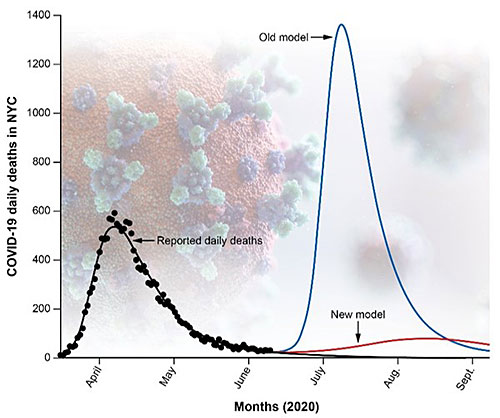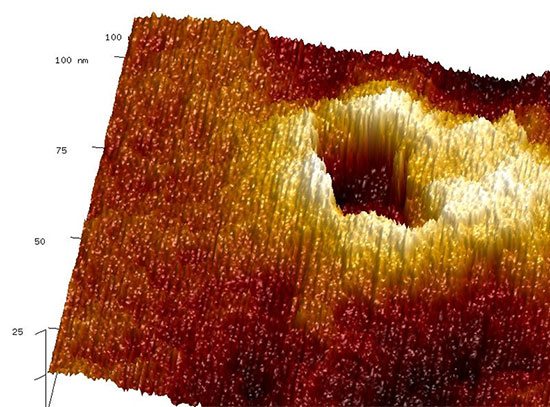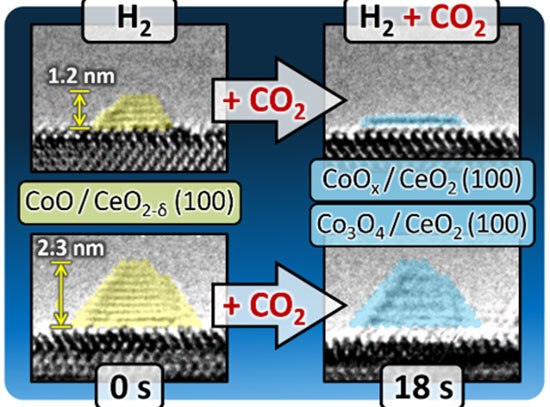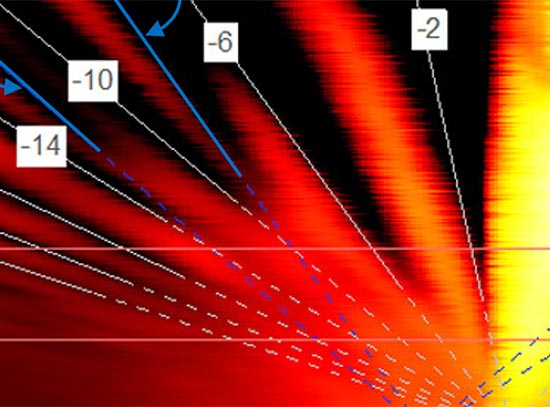New Model Shows NYC May Avoid a Second COVID-19 Wave
August 31, 2020
 enlarge
enlarge
Projected daily deaths in NYC during a potential second wave of COVID-19. The model accounting for social and biological population heterogeneity predicts a largely suppressed second wave (red and black lines) compared to a model without these considerations (blue line). Reported daily deaths are represented as black circles.
What is the scientific achievement?
In collaboration with scientists at the University of Illinois Urbana-Champaign, CFN staff developed a new epidemiological model for COVID-19 transmission that considers heterogenous social and biological susceptibility of the population to viral infection and transmission. In assessing the model’s accuracy, the team used data from the COVID-19 epidemic in New York City (NYC), Chicago, and each of the 50 U.S. states.
Why does this achievement matter?
The new model predicts that hardest-hit areas, such as NYC, may be approaching herd immunity and thus substantially protected against a second COVID-19 wave. However, this type of immunity is fragile and can decrease over time with changes in social interactions.
What are the details?
It has become increasingly clear that the COVID-19 epidemic is characterized by overdispersion whereby the majority of transmission is driven by a minority of infected individuals. Such a strong departure from the homogeneity assumptions of the traditional well-mixed compartment model is usually hypothesized to be the result of short-term super-spreader events, such as an individual's extreme rate of virus shedding at the peak of infectivity while attending a large gathering without appropriate mitigation.
However, we demonstrate that the spread of epidemics is primarily sensitive to long-term, or persistent heterogeneity, of individual susceptibility or infectivity. We demonstrate how to incorporate this heterogeneity into a wide class of epidemiological models and derive a nonlinear dependence of the effective reproduction number Re on the susceptible population fraction S. Compared to the effects of short-term overdispersion, persistent heterogeneity has three important consequences: (1) It results in a major modification of early epidemic dynamics; (2) It significantly suppresses the herd immunity threshold; and (3) It significantly reduces the final size of the epidemic.
We estimate social and biological contributions to persistent heterogeneity using data on real-life face-to-face contact networks and age variation of the incidence rate during the COVID-19 epidemic. In addition, empirical data from the COVID-19 epidemic in NYC, Chicago, and each of the 50 U.S. states provide a consistent characterization of the level of heterogeneity. Our estimates suggest that the hardest-hit areas, such as NYC, are close to the heterogeneity-modified herd immunity threshold following the first wave of the epidemic. However, this type of immunity is fragile, as it wanes over time if the pattern of social interactions changes substantially.
CFN Capabilities
The CFN Theory and Computation Facility was used for this collaboration.
Publication Reference
A.V. Tkachenko, S. Maslov, A. Elbanna, G. N. Wong, Z. J. Weiner, N. Goldenfeld, Persistent heterogeneity not short-term overdispersion determines herd immunity to COVID-19, medRxiv 2020.07.26.20162420 (2020).
DOI: https://doi.org/10.1101/2020.07.26.20162420
Acknowledgement of Support
This work was supported by the University of Illinois System Office, the Office of the Vice-Chancellor for Research and Innovation, the Grainger College of Engineering, and the Department of Physics at the University of Illinois at Urbana-Champaign. Z.J.W. is supported in part by the United States Department of Energy Computational Science Graduate Fellowship, provided under Grant No. DE-FG02-97ER25308. A.E. acknowledges partial support by NSF CAREER Award No. 1753249. This work made use of the Illinois Campus Cluster, a computing resource that is operated by the Illinois Campus Cluster Program (ICCP) in conjunction with the National Center for Supercomputing Applications (NCSA) and which is supported by funds from the University of Illinois at Urbana-Champaign. This research was partially done at, and used resources of the Center for Functional Nanomaterials, which is a U.S. DOE Office of Science Facility, at Brookhaven National Laboratory under Contract No. DE-SC0012704. The calculations were performed with data provided by the Illinois Department of Public Health through a Data Use Agreement with Civis Analytics.
2020-17444 | INT/EXT | Newsroom









